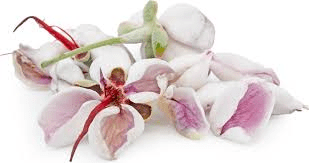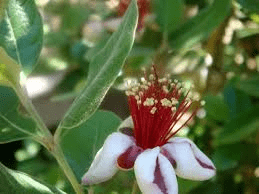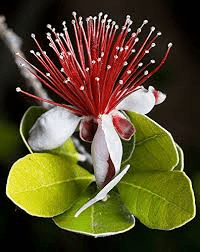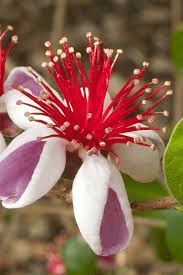Guava styles are an essential part of the guava flower’s reproductive system, belonging to the genus Psidium in the Myrtaceae family. They play a key role in the fertilization process, acting as the pathway through which pollen tubes travel to reach the ovules within the ovary. The style, along with the stigma and ovary, constitutes the pistil, which is the female reproductive organ of the flower.
The style is a slender, elongated structure that connects the stigma at its upper end to the ovary at its lower end. Its primary function is to provide a route for pollen tubes to grow from the stigma to the ovary after pollination occurs. The length and structure of the style can vary among different guava varieties, but it is generally long enough to extend well beyond the other floral parts, ensuring that it can efficiently capture pollen from pollinators or wind.
When a pollen grain lands on the sticky surface of the stigma, it germinates and forms a pollen tube. This pollen tube grows down through the style, guided by chemical signals released by the ovary. The style facilitates this growth by providing a supportive and nutritive environment for the pollen tube. Inside the style, specialized cells secrete nutrients and signaling molecules that aid in the elongation of the pollen tube and direct its growth toward the ovary.
The tissue structure of the guava style includes a central transmitting tissue surrounded by layers of supportive cells. The transmitting tissue is composed of specialized cells that produce extracellular matrix components, creating a conducive environment for pollen tube growth. This tissue also helps guide the pollen tubes toward the ovary, ensuring that fertilization can occur efficiently.
Environmental factors such as temperature, humidity, and nutrient availability can influence the development and functionality of the guava style. Optimal conditions are necessary for the healthy development of the style and its ability to support pollen tube growth. Adverse conditions such as extreme temperatures, drought, or nutrient deficiencies can impair the style’s function, potentially leading to reduced fertilization success and lower fruit yield.
The successful passage of the pollen tube through the style is crucial for fertilization. Once the pollen tube reaches the ovary, it penetrates an ovule and releases sperm cells, which fertilize the egg cell within the ovule. This fertilization process initiates the development of seeds and triggers the transformation of the ovary into the fruit. The health and functionality of the style are therefore directly linked to the reproductive success of the guava plant and its ability to produce viable seeds and fruit.
In summary, guava styles are vital reproductive structures that connect the stigma to the ovary and facilitate the growth of pollen tubes during the fertilization process.
The style’s supportive and nutritive environment ensures the efficient transport of pollen tubes, leading to successful fertilization and fruit development. The structure and function of the style, influenced by environmental factors, are crucial for the reproductive health and productivity of the guava plant. Understanding the role of the guava style can help in improving cultivation practices and optimizing fruit yield.
The Economic Importance and Uses of Guava Styles

1. Herbal Medicine: Guava styles are used in traditional medicine for their potential health benefits, including antimicrobial and antioxidant properties.
2. Natural Dyes: Pigments extracted from guava styles can be used as natural dyes for textiles and crafts.
3. Composting Material: Guava styles can be composted to create organic fertilizer, enriching the soil.
4. Mulch: Shredded guava styles are used as mulch to retain soil moisture and suppress weed growth.
5. Potpourri: Dried guava styles are used in potpourri for their natural fragrance and aesthetic appeal.
6. Skincare Products: Extracts from guava styles are incorporated into skincare products for their beneficial properties.
7. Animal Feed: Guava styles can be used as a supplementary feed for livestock.
8. Biofertilizer: Compost made from guava styles can be used as a biofertilizer to enhance soil health.
9. Natural Pest Repellent: Extracts from guava styles can be used to create natural pest repellents for crops.
10. Charcoal Production: Guava styles can be processed into charcoal, which is used as a fuel and in various industrial applications.
11. Craft Materials: The styles are used in crafting to create decorative items and art.
12. Eco-friendly Packaging: Guava styles can be processed into biodegradable packaging materials.
13. Soil Erosion Control: Guava styles can be used in projects to control soil erosion and stabilize land.
14. Biomass Energy: They can be used as biomass for generating renewable energy.
15. Fertilizer Additive: Guava styles can be added to fertilizers to enhance their nutrient content.
16. Animal Bedding: Dried styles can be used as bedding material for livestock.
17. Environmental Conservation: Guava styles contribute to environmental conservation by improving soil health and preventing erosion.
18. Artistic Uses: Guava styles are used in artistic projects and crafts for their unique appearance.
Read Also: How to Raise Catfish and Tilapia in the Same Fish Pond at the Same Time
The Products and By-products That Can Be Derived From Guava Styles

1. Natural Dyes: Pigments from guava styles are extracted for use as natural dyes.
2. Compost: Guava styles are composted to produce nutrient-rich compost for soil improvement.
3. Mulch: Shredded styles are used as mulch to conserve soil moisture and control weeds.
4. Potpourri: Dried styles are used in potpourri mixes for their fragrance.
5. Skincare Products: Extracts from guava styles are incorporated into creams and lotions for their skin benefits.
6. Animal Feed: Styles are used in feed mixtures for livestock.
7. Biofertilizer: Compost made from guava styles is used as a biofertilizer.
8. Natural Pest Repellents: Extracts are used to make natural pest repellents.
9. Charcoal: Styles can be carbonized to produce charcoal for fuel.
10. Craft Materials: Guava styles are used in crafting and decorative projects.
11. Eco-friendly Packaging: Processed styles are used in biodegradable packaging.
12. Soil Erosion Control: Guava styles are used to prevent soil erosion and stabilize land.
13. Biomass Energy: Styles are used as biomass for renewable energy generation.
14. Fertilizer Additive: Guava styles are added to fertilizers to enhance their nutrient content.
15. Animal Bedding: Dried styles are used as bedding for livestock.
16. Environmental Projects: Styles contribute to environmental conservation efforts.
17. Artistic Projects: Guava styles are used in art and craft projects for their aesthetic qualities.
18. Soil Conditioner: Guava styles are used as soil conditioners to improve soil structure and fertility.
Read Also: Toyger Cat Breed Description and Complete Care Guide
Frequently Asked Questions (FAQ’s) About Guava Styles

1. What are the uses of guava styles in traditional medicine?
Guava styles are used for their antimicrobial and antioxidant properties in traditional medicine.
2. How can guava styles be used as natural dyes?
Pigments from guava styles are extracted and used to dye textiles and crafts.
3. Can guava styles be used in composting?
Yes, guava styles can be composted to enrich soil with organic matter and nutrients.
4. How are guava styles used in skincare products?
Extracts from guava styles are incorporated into skincare products for their beneficial properties.
5. Are guava styles effective as a natural pest repellent?
Yes, extracts from guava styles can be used to create natural pest repellents for crops.
6. Can guava styles be used for energy production?
Yes, they can be used as biomass for generating renewable energy or processed into charcoal.
7. How are guava styles used in crafting?
Guava styles are used to create decorative items and art due to their unique appearance.
8. What is the role of guava styles in soil erosion control?
They are used in projects to stabilize soil and prevent erosion.
9. How can guava styles be used in eco-friendly packaging?
Processed guava styles are used to create biodegradable packaging materials.
10. Can guava styles be used as animal feed?
Yes, guava styles can be used as supplementary feed for livestock.
Read Also: Adaptive Means of Animals Coping with the Environment






